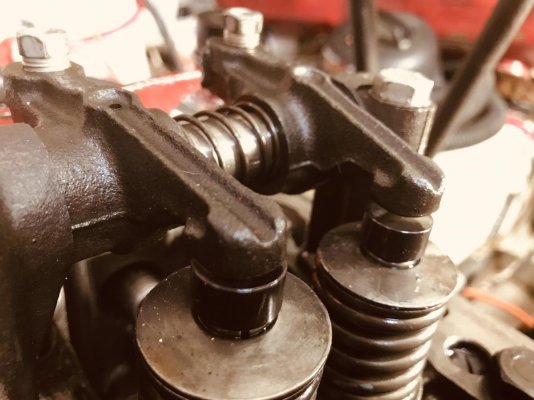warfdog
Veteran Member
- Joined
- May 21, 2018
- Messages
- 96
- Location
- USA
- Vessel Name
- Voyager
- Vessel Make
- Universal 39' Europa Trawler
Hello lehman experts,
I've been working hard on Voyager over the last year to rewire and refinish the interior, but at a slow pace as I have little time. As a result I have not taken the time to run the engine/transmission since a 50km relocating cruize 12 months ago.
I have great hopes for this great old boat...and now the engine is seized, the tanks are rusty, the engine stringer are rotten, the hull has blisters, the batteries need replacing, a windshield is cracked, the teak decks leak..I still love the boat.
Last year, on the most recent cruise, it ran well but tended to run hot between 200-220 indicated. Later, Brian at American Marine warned me that running it that hot would likely do havoc on #6. I thought 'good to know' and hope it didn't do any harm yet and that gauges were off.
Now, to my surprise this seems to have already turned into the worst case. I can NOT even bar it over one-degree by hand standing on a cheater bar, I verified the starter is kicking out a ton of torque and engaging/disengaging, but nothing can move the crank at all. It looks totally internally seized.
Fearing hydro-locking I pulled all of the injectors, but there is no sign of water in any cylinders. Oil was just changed before that last trip and it's still clean and clear. All of the valves move freely by hand except for the #6 exhaust valve which is frozen in an open position pic below.
Engine hours are less than 3,000 and the engine wasn't smoking or making any unusual noise. Given the weight of the head and my limited experience on the Lehman, I'm planning to have a mechanic come out and look at it. I don't think it's the damper. But I would love to see if anyone has ideas on what I did to it and how to utilize the mechanic. I'm willing to throw money at it but need to figure out where to start.
Did #6 break off and drop a valve? Can a borescope see that through the injector port? Any chance when it overheated did I just melt piston #6 to the sleeve? Can a repair be done onboard or should I have it towed to a yard where the engine can be pulled? Should I have a mechanic pull the head where it is to inspect, or is it inevitable that the engine needs to come out to repair?
I know the answer lies in having an assessment from a qualified mechanic, but don't we all like to speculate where I should spend some boat bucks?
Figuring out next steps since I have to move the boat one way or another for dredging that is starting in about a week. I can haul it over to the guest dock and have a mechanic look at it, or I can have Sea Tow take it straight to a boatyard and pull the whole engine out for repair, rebuild or repower?
Thx,
Captain Warfdog
Westpoint Harbor
San Francisco Bay
I've been working hard on Voyager over the last year to rewire and refinish the interior, but at a slow pace as I have little time. As a result I have not taken the time to run the engine/transmission since a 50km relocating cruize 12 months ago.
I have great hopes for this great old boat...and now the engine is seized, the tanks are rusty, the engine stringer are rotten, the hull has blisters, the batteries need replacing, a windshield is cracked, the teak decks leak..I still love the boat.
Last year, on the most recent cruise, it ran well but tended to run hot between 200-220 indicated. Later, Brian at American Marine warned me that running it that hot would likely do havoc on #6. I thought 'good to know' and hope it didn't do any harm yet and that gauges were off.
Now, to my surprise this seems to have already turned into the worst case. I can NOT even bar it over one-degree by hand standing on a cheater bar, I verified the starter is kicking out a ton of torque and engaging/disengaging, but nothing can move the crank at all. It looks totally internally seized.
Fearing hydro-locking I pulled all of the injectors, but there is no sign of water in any cylinders. Oil was just changed before that last trip and it's still clean and clear. All of the valves move freely by hand except for the #6 exhaust valve which is frozen in an open position pic below.
Engine hours are less than 3,000 and the engine wasn't smoking or making any unusual noise. Given the weight of the head and my limited experience on the Lehman, I'm planning to have a mechanic come out and look at it. I don't think it's the damper. But I would love to see if anyone has ideas on what I did to it and how to utilize the mechanic. I'm willing to throw money at it but need to figure out where to start.

Did #6 break off and drop a valve? Can a borescope see that through the injector port? Any chance when it overheated did I just melt piston #6 to the sleeve? Can a repair be done onboard or should I have it towed to a yard where the engine can be pulled? Should I have a mechanic pull the head where it is to inspect, or is it inevitable that the engine needs to come out to repair?
I know the answer lies in having an assessment from a qualified mechanic, but don't we all like to speculate where I should spend some boat bucks?
Figuring out next steps since I have to move the boat one way or another for dredging that is starting in about a week. I can haul it over to the guest dock and have a mechanic look at it, or I can have Sea Tow take it straight to a boatyard and pull the whole engine out for repair, rebuild or repower?
Thx,
Captain Warfdog
Westpoint Harbor
San Francisco Bay



